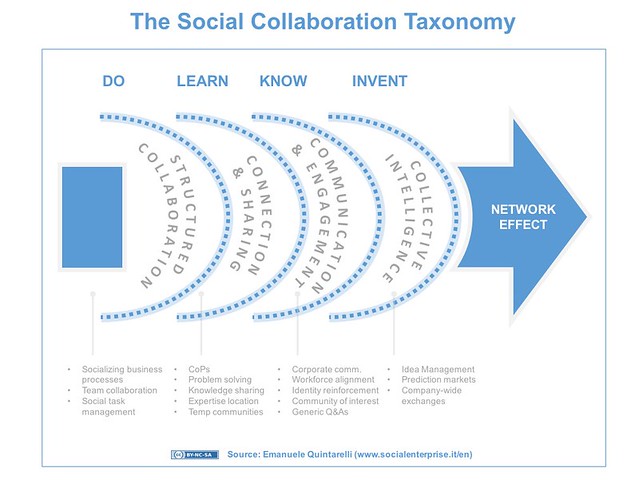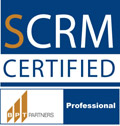As our Social Collaboration Survey demonstrated, user adoption is clearly the top concern for many large enterprises where senior management struggles to convince the rest of organization to transition towards more participative, transparent and agile ways of working.
Nonetheless even companies that are mature enough to win the adoption battle quickly learn how participation may bring other and much more subtle questions such as:
- How to prevent chaos while still stimulating a pervasive user adoption?
- How to orchestrate communities in order to facilitate search and contribution for end-users?
- How to guide the creation of new communities as to reduce fragmentation, duplication and redundancy?
- How to strategically prioritize different types of community-based interaction (i.e knowledge sharing vs innovation)?
- How to provide a simple navigation scheme that will guide users to the communities of their interest?
- How to be sure that the most impactful outcomes collaboration can deliver will all be delivered eventually?
- How to gradually transition participants from less to more intensive (and thus more complex from a change management perspective) collaboration scenarios?
If enterprise collaboration is inspired to social media, participation should autonomously emerge and self organize, right? Wrong!
In order to achieve a purposeful, business-focused transformation, the design and launch of communities cannot be left to chance but, on the other side, a strict top-down taxonomy would most certainly dissipate energy and stifle the ability to reach critical mass.
Is there a middle ground then? How does it look like?
A first great answer has been provided by BASF by categorizing communities based on the originating actor (from) and their main recipient (for). Choosing between employees and the organization for each dimension, the model suggests four quadrants or types of communities (experts and professions focused on expertise, projects and teams focused on practice, personal networks focused on interest, initiatives and organizational units focused on engagement).
BASF’s model is neat and still powerful in bringing order to community design. Yet in my humble opinion some areas for improvement still remain:
- It is not comprehensive. For example it doesn’t include idea management, a prevalent application of collaboration to innovation. Others company-wide communication mechanisms are also missing, I guess partly because the quadrants have been created back in 2010.
- I find the from – to classification a bit arbitrary / difficult to use. As an example, are communities of practice (experts and professions) really driven from employees? Most organizations purposely launch them to connect like-minded individuals across silos. Are projects really originated by the organization? Most groups simply decide to come together online as to simplify their daily chore.
- There is no direction. The model is 100% neutral both in terms of business value generated and barriers of access that employees must overcome. Knowing where to start based on the expected impact and resistance helps a lot with adoption.
I’d suggest the model can be further improved to answer most of the initial questions, by leveraging the strength of weak ties by Mark Granovetter:

Instead of focusing on one-to-one interactions or tools supporting them as many of us did in the past (Andrew McAfee with its bull’s eye diagram, Nial Cook with its 4Cs model and even I with the Enterprise 2.0 Framework), the Social Collaboration Taxonomy looks at the purpose communities and other collaborative constructs fulfill for employees.
Going from stronger (left side) to weaker ties (right side), the different collaboration archetypes are:
- Structured collaboration – Do: the one you experience with a team of members you know personally and interact with daily, for a shorter or longer period of time. Both the goals and the deadline of the initiative are given (everybody works to achieve the same outcome within the same timeline) but the level of formality of interactions vary from processes (very codified exchanges) to projects (not codified flows).
- Connection & sharing – Learn: it is the land of communities of practice. Employees from different teams, departments, countries flock together to solve complex issues, learn, meet the expert or, more lightly, to augment a temporary experience (i.e a learning course). Trusted relationships are the currency for transparent knowledge creation and circulation.
- Communication & engagement – Know: sharing values and strategic directions, achieving internal alignment, building a sense of belonging appear to be among the top priorities of Internal Communication departments. Communities can make all of them easier to address but also more interactive and human (i.e engaging employees in co-defining the strategy).
- Collective intelligence – Invent: the last ring is all about innovation with hundreds or often thousands of employees providing ideas, votes or bets to improve processes and products. Very weak ties but among potentially huge and massively dispersed groups of individuals
Each collaboration archetype is simple and distinctive enough to be categorized under a single word (it could be a navigation label in your homepage) and yet all the major collaborative interventions appear to be captured.
The diagram can be also used to align collaboration to business goals: structured collaboration to get job done in existing organizational structure or as part of redesigned processes, connection & sharing to let knowledge cut across silos, communication and engagement to improve corporate communications, collective intelligence to accelerate innovation.
As a last note, by going through the diagram backwards, from right to left, we have a sort of collaboration funnel. The rightmost side works on network effects where large groups unlock outcomes through very small contributions (an idea, a vote). The way of working doesn’t need to be dramatically upended. Thanks to a better engagement, peer-to-peer relationships and a stronger sense of identity employees can at some point decide to participate more frequently and more intensively, up to a point where collaboration simply becomes a better way of working. A paradigm centered on transparency, sharing as the default behavior, leveraging experts from other parts of the organization and employees playing a role even in traditional top-down communications.
What do you think? Are you aware of other “taxonomies” to guide community design? I’d be grateful to hear your comments.
